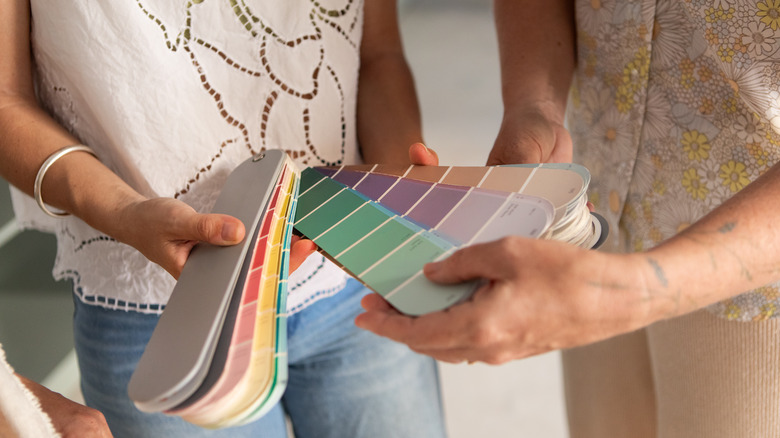The Unbeatable Trick For Testing Neutral Paint Colors On A White Wall
There's often a sense of underlying stress when you're testing colors that are neutral, especially when the wall you're testing them on is white. Sure, you may think beige is just beige, but the minute you slap some of it on a white wall, it can look quite different, which can be jarring at first. Well, one clever creator on Instagram shared a surprising hack for solving this age-old problem, suggesting getting up close to the swatch, placing your hand gently over the middle, and looking at it that way (or through your camera lens to take a photo).
Your hand next to the swatch will give your brain a truer read on what the color actually looks like in a much more effective way than just seeing it against stark bright white. Much like the tests that'll help you determine the undertone of your paint color, it's a little trick that, in the long run, could save you a few trips back to the hardware store to find a neutral color you actually love. Brushing your neutral paint swatches directly onto a white wall will create a contrast between the stark white and the muted tones.Think of it like your eye being tricked by the brightness around it, which exaggerates the color, or makes it look different.
The optical illusion at play
So the reason this hack works is possibly due to some little optical illusions at work. Because light bounces off white walls, seeing other shades against the white may skew how our eyes are able to see more subtle tones. It could also come down to the Bezold effect, which suggests that colors appear different depending to the colors near them so against a white wall a soft warmth may suddenly look cold, or a sandy shade might appear almost orange. However, by bringing your hand into the frame, we can infer this provides your eyes with a neutral buffer that allows the paint to appear more balanced. It's sort of like giving your eyes a reference point, so your skin tone softens the glare of the white wall and reframes the new color in the context of your hand — something your brain knows as familiar. While this explanation makes sense we should be noted that this is one creator's idea and not necessarily a scientifically proven technique.
And the process of picking the perfect shade of paint is not one to be rushed, even when you're looking for a more neutral tone. It will take time because shades can vary wildly depending on the wall you're testing them on and the lighting in the room itself. So try as many samples as you need, use the hand trick, and once you've finally made your choice, don't forget to repurpose your paint samples – they make great mini DIY touch-up kits or even small art projects.

